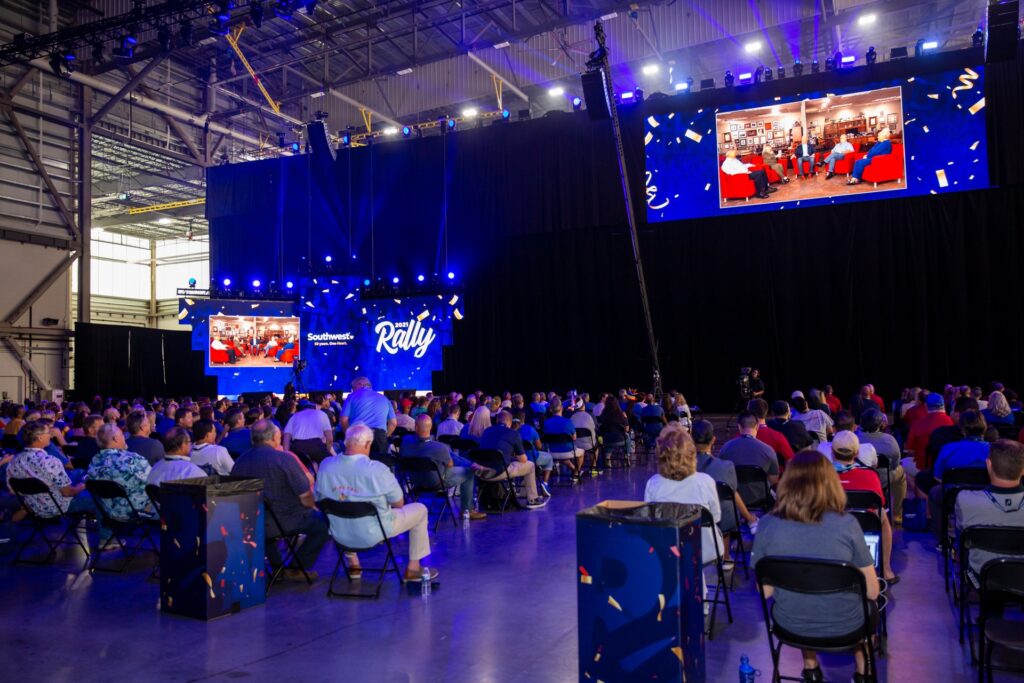Hybrid is Here to Stay (but not for everyone)
It’s true that many organizations are tossing their webcams right out the window and booking up hotel and convention center space at a rapid clip. We know firsthand the value that face-to-face interaction has on increasing motivation, productivity and overall engagement of your people and your culture. And largely, we’ve seen a return to traditional live meetings and events similar to what we all were accustomed to prior to 2020.
But many brands have discovered the benefit virtual streaming contributed during the pandemic and are continuing to walk before they run. By planning a hybrid experience, you can maximize the engagement of your audience while simultaneously making the event more accessible – particularly for larger, global audiences. Increased demand on event space, higher airfare and fuel prices all make hybrid events an attractive model to continue to lean on in 2022 and beyond.
Benefits of Hybrid Events
Improved Reach & ROI
Seems like a no-brainer, but we learned a lot in the last two years. Employees no longer just appreciate flexibility, but demand it, especially Millennials and Gen Z who also highly value the lower carbon footprint of not traveling if they don’t have to. Offering a virtual streaming option to your in-person event allows you to reach your extended audience, while reducing the cost of travel and lodging. It can also solve for venue capacity to make sure your entire audience has the ability to view live content, especially in an ever-increasingly competitive market for event space.
Extended Learning
For parents of young children, the term “asynchronous learning” may give you chills, but hybrid events also mean more than just streaming in-person content. Creative strategies to re-think the traditional live experience can extend learning and development with a greater impact. This includes asynchronous activities leading up to the event for all participants and additional learning for your virtual audience to make sure they are as engaged as those in the room. By streaming your event, you also have recorded content for use well beyond the experience for use in marketing, recruiting, onboarding and development.
Detailed Analytics
How many people actually watched this? Technology has come a long way and detailed analytics provide not just macro data, but down to the individual attendee. How many sessions they viewed, for how long, from what device and location, and much more. This data can support whether to continue with a hybrid model moving forward or how to shift your event strategy entirely.
Download Our eBook: 8 Fundamentals of an Internal Communications Strategy
If your people are sending out the “whatever” vibes, it’s time to get back to the basics. Make sure your internal communication strategy is following 8 fundamentals to cultivate an engaged workforce aligned with your company’s success.
Hybrid Events Will Continue to Evolve
Hybrid events are certainly not a new concept, however these types of gatherings have never been hosted with such frequency as they have over the last two years. And while initially fueled by the pandemic, the hybrid event ecosystem is still taking shape. In 2022, look for hybrid events to continue to evolve. Event hosts will leverage emerging technologies to make these gatherings even more immersive for digital attendees. This increased tech use will result in better engagement and seamless interactions between live audiences, virtual participants and presenters.
Hybrid Events Will Fuel Technology Development
The push to craft more immersive and interactive hybrid events will propel a rapid advance in communication technology development. We see it happening all around us. While it’s unclear where exactly these advancements across XR and the metaverse will take us, one thing we know for sure is that brands who stay on the bleeding edge will take the lead in audience engagement.
Lastly, brands and event hosts will make developing relationship-centric strategies a top priority in 2022. In short, a relationship-centric approach is a communication plan that is designed to nurture trust, forge deeper connections with audience members, and build lasting relationships. A hybrid event strategy can be a key part of that. This approach allows organizations to build brand loyalty and set themselves apart in a marketplace where the demand for talent and people development has never been greater.
Unsure if a hybrid experience is right for you? Let’s chat. Our two cents is always free, we’ll even buy you lunch.





